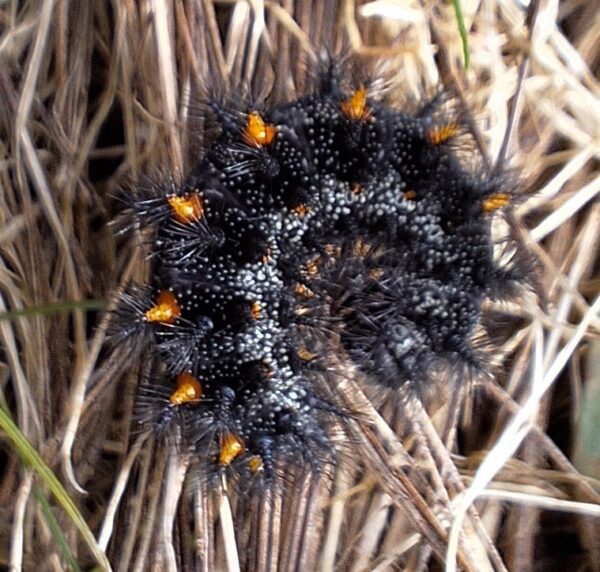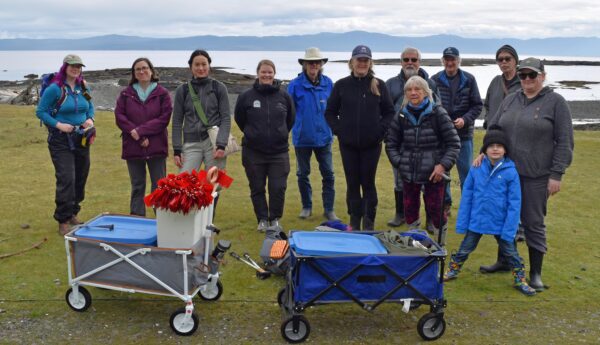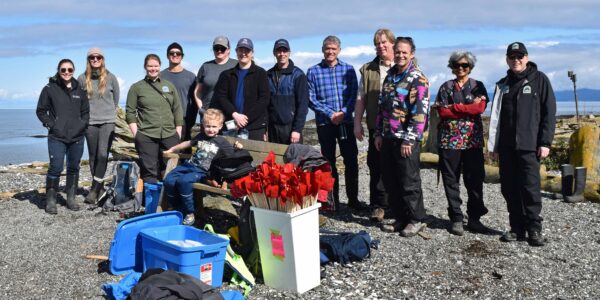Major milestone for Taylor’s checkerspot butterflies in Helliwell
By Chris Junck, Taylor’s Checkerspot Butterfly Recovery Project Team
The Taylor’s Checkerspot Butterfly Recovery Project Team is excited to share some great news.
Last year the team released 1,476 Taylor’s checkerspot butterfly caterpillars in Helliwell Provincial Park’s coastal bluff meadows. Many of those larvae metamorphosed into adult butterflies. Several butterflies mated and produced thousands of eggs. More than 1,900 larvae hatched and went through one or more stages before they stopped eating and grouped together in larval webs. The larvae then changed into their overwintering diapause stage. This March, Pascale Archibald and Kihan Yoon-Henderson found more than 230 larvae that survived the winter to continue their lifecycle.

This March, Pascale and Kihan found more than 230 Taylor’s checkerspot larvae that are offspring of butterflies released in Helliwell in 2023. Photo by Chris Junck.
“This is a significant milestone for the project. It’s the first time since 1996 that we have documented proof that Taylor’s checkerspot butterflies successfully completed their entire lifecycle in Helliwell Provincial Park,” said Jennifer Heron, project lead and provincial invertebrate conservation specialist. She added, “This is a hopeful sign that our coastal bluff habitat restoration work and other Taylor’s checkerspot butterfly recovery efforts in the park are succeeding.”

One of the offspring of Taylor’s checkerspot butterflies that were released in 2023. It is the first time since 1996 that there is documented proof that the butterflies completed their entire lifecycle in the park. They’re proof that the habitat restoration and other butterfly recovery initiatives in Helliwell are succeeding. Photo by Chris Junck.
This spring, the team released more Taylor’s checkerspot butterfly caterpillars that were raised at the Greater Vancouver Zoo by Wildlife Preservation Canada staff Andrea Gielens. On March 25, representatives of the Hornby Island Provincial Parks Committee, Conservancy Hornby Island, and the Hornby Island Natural History Centre (Neil Wilson, Bill Caywood, Joanne Wyvill, Bill Hamilton, Ondrea Rogers, and Don Peterson) helped introduce 100 larvae to their new habitat near St. John’s Point in Helliwell Provincial Park.

St. John’s Point larval release group, L to R: Pascale Archibald, Ondrea Rogers, Kihan Yoon-Henderson, Stephanie Govier, Bill Caywood, Jennifer Heron, Don Peterson, Joanne Wyvill, Neil Wilson, Bill Hamilton, Eddy Geilens, Andrea Geilens. Photo by Chris Junck.
On the following day, the team released 340 larvae for the first time on Flora Islet, which is also part of Helliwell Provincial Park. The warm, sunny weather was ideal for the caterpillars, and they began searching for food immediately. They didn’t need to go far. They were placed on plantain, which is one of their favourite food sources. Flora Islet may be a great location for the checkerspots – food plants are abundant for larvae to munch, and there are plenty of flowering plants such as spring gold, camas, small-flowered blue-eyed Mary, and sea blush with nectar for the adult butterflies.

Flora Islet caterpillar release group. L to R: Rachel Shanner, Alex Vallee, Stephanie Govier, Eli Simcoe Metcalfe, Andrea Gielens, Jennifer Heron, Micheal Badry, Nick Page, Derek Moore, David Hendrickson, Purnima Govindarajulu,, David Ranson. Eddie Geilens sitting on bench. Photo by Chris Junck.
This is a critical period for the caterpillars. They need to find enough high-quality food to be able to grow and transform through their life stages. The caterpillars are tiny, delicate, and vulnerable. Trampling by park visitors and dogs are a key threat to the larvae and the plants they need to survive.

Taylor’s checkerspot caterpillars are gently transferred by paintbrush to plantain. Photo by Don Peterson.
Helliwell’s visitors can increase the caterpillars’ chance of survival by adhering to park rules. “Dogs must be on a leash according to provincial park regulations, and bikes aren’t allowed in this park,” said Stephanie Govier, BC Parks conservation specialist. Please tread carefully and watch out for caterpillars. Stay on the trails that are delineated by ropes and restoration area signs. If you visit Flora Islet, stay on the shore, and avoid the fragile meadows. This will reduce the possibility of stepping on a caterpillar or their host plants.

Flora Islet has lush meadows of ribwort plantain, small-flowered blue-eyed Mary and other plants that provide food for larvae and nectar for adult butterflies. If you visit the Islet, please stay on the shore to avoid trampling the delicate meadows and caterpillars. Photo by Chris Junck.
Don’t move or pick up Taylor’s checkerspots. Instead, report sightings to Taylors.Checkerspot@gov.bc.ca, or by using the free iNaturalist app (www.inaturalist.org). It is an easy-to-use species identification tool that enables citizen scientists to record and contribute important species data for projects around the globe.
BC Parks and the project team thank the Cowichan Tribes, Halalt, Homalco, K’ómoks, Lake Cowichan, Lyackson, Penelakut, Qualicum, Snaw’Naw’As, Stz’uminus, Tla’amin, We Wai Kai, and We Wai Kum First Nations for allowing us to restore ecosystems in their traditional territories. Several local volunteers from Conservancy Hornby Island, the Hornby Island Natural History Centre, the Hornby Island Provincial Parks Committee, residents of High Salal Ranch, and others also contributed to the success of this wetland project.
The recovery project has benefited from funding and in-kind contributions from the BC Parks Licence Plate Program, the Habitat Conservation Trust Foundation, the Environment Canada Habitat Stewardship Fund, and the B.C. Ministry of Environment and Climate Change Strategy (Ecosystems Branch), and others.
The Taylor’s Checkerspot Butterfly Recovery Project Team includes biological consultants and representatives from the B.C. Ministry of Water, Land and Resource Stewardship, B.C. Ministry of Environment and Climate Change Strategy, BC Parks, Denman Conservancy Association, Garry Oak Ecosystems Recovery Team, Greater Vancouver Zoo, Mosaic Forest Management, Wildlife Preservation Canada, and others.
Learn more about the Taylor’s checkerspot butterfly: goert.ca/activities/ and gov.bc.ca/taylors-checkerspot